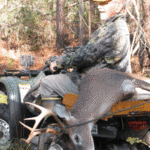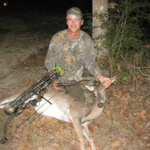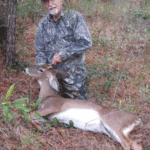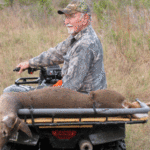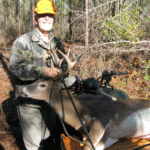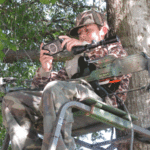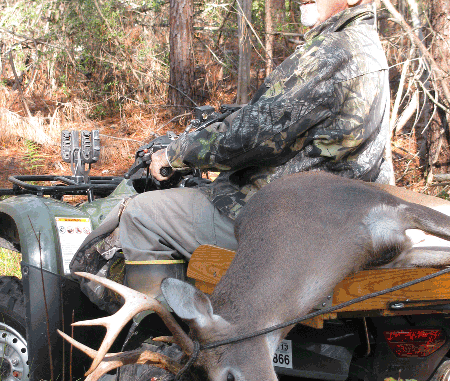
Strip malls and subdivisions are slicing up Louisiana’s piney woods, but that doesn’t mean the deer have gone anywhere. Here’s the best way to take one of these suburban deer.
By 8:20 a.m. five text messages had alerted me to many vital matters.
“Remember I gotta get home in time for the Saints-Colts tailgate party!” read one.
“Wait till you see my Harry Potter Halloween costume!” read another.
“Saw some squirrels — but not as many as in my backyard. Can I bring my air rifle next time? And pop a few squirrels? Looks like they really, really like this corn. And here comes a raccoon! I thought you said this place was full of deer? Well, I haven’t seen any yet?”
This last one had, in fact, been the first one, beeping through at 7:45 a.m. — a full 55 minutes after my nephew Phillip finally got strapped up in his ladder stand. Probably his grandfather, about 200 yards away in another ladder stand, had gotten as many, if not more.
Luring Phillip into the realm of deer hunting took some doing. Oh, OK — I’ll be honest. It actually took some bribing.
A crossbow was part of the price. This gadget, after all, looks like one of those wicked weapons a Marvel Comics or PlayStation Warrior might wield.
Now a plain bow? Even a compound with all the gadgets? Well, compared to a fully-equipped crossbow, a compound bow looks pretty “boring,” as I was repeatedly informed.
And speaking of “boring.” Try teaching a kid the basics and fundamentals of bow hunting lately — and good luck.
Oh, I realize exceptions exist, and probably many of them. My kudos to these kids and (especially) to their trainers. But let’s be practical here.
Little Phil’s many practice sessions with the crossbow just made the gadget so “cool” it actually graduated to “awesome!” As October kicked in he was seriously pumped to try it out and perhaps contribute to the Bambi burgers and nachos he’d become so fond of during family gatherings.
The temp finally dropped into the 40s, and off we went to the still-lush Southeast Louisiana piney woods to climb stands and watch over scattered corn — while fully equipped with iPads, of course.
No food plots and camp and ATVs and all the attendant hoopla on our family “lease.” It consists of 110 acres belonging to an uncle of a close friend, and is closely encircled (and quickly giving way) to “urban sprawl.”
But the place is ideal for easy, convenient quasi-suburban bow and crossbow deer hunts. And “Uncle Gus,” the landowner, was happy to have our visible presence on the property; it keeps the dumpers, litterers and dope fiends away.
From St. Francisville around to Denham Springs and eastward through Hammond, Mandeville to Slidell, it’s becoming all too familiar: strip malls and subdivisions sprouting like mushrooms after a rain, with many hunters losing their leases or portions of their leases as a result. And with many ugly incidents between the new residents to these quasi-rural subdivisions and people gun hunting in the vicinity.
Bow hunting provides an accommodation to this problem. But we’re all friends here, so let’s admit another rationale: For most people, a bow is a pretty inefficient tool for cleanly killing and quickly finding a shot deer. There, I said it.
I know, I know, some people are experts at the game and pride themselves on their hunting skills, marksmanship, etc. etc., required to consistently kill deer with a bow. Great, I salute them. More power to ’em.
But then there’s the rest of us — the vast majority. I strongly suspect the number of arrow-stuck but lost deer is much higher than most of us like to admit. And I know many hunters who’ve given up bow hunting entirely because of one or several such gut-wrenching episodes.
So allowing crossbows for all hunters, as promulgated by the LDWF four years ago, strikes me as an absolutely splendid move. My father has used one for years, as has Pelayo (due to a physical handicap which made drawing a bow impossible.) Neither of these crossbow hunters has ever hit a deer and then lost it. (Wish I could claim the same with my bow, even though I practice often and have never taken a shot over 23 yards.)
And now some of the “young-uns” are coming on board, probably because of the “awesome” looks of a crossbow. Add the chance to rev up and ride an ATV, and we’re talking some serious enticements.
Since crossbows are louder than compounds, some hunters cite deer “string-jumping” a crossbow bolt as a major issue. All I can say: It has never happened in our experience. Indeed clean kills, heavy blood trails and quick finds are not only the norm but the case on every one of our hits.
In fact, trailing is often unnecessary. After the shot, the cross-bow hunter usually watches the deer fall after a short run — usually a shorter run than that of a lung- or heart-hit with a rifle!
I’ve been involved in the “tracking” of most of Dad’s and Pelayo’s deer, and have never seen one go much over 60 yards. For whatever reason, with a crossbow-powered arrow through the vitals (lungs typically), they drop more quickly than many of the deer we blast through the heart or lungs with a 150-grain soft-point from a .30-06! I kid you not.
You aim a little too far forward with a crossbow, and hit the shoulder bone — no problemo. The arrow blasts right through to the vitals. Neck and spine hits mean instant drops.
I say crossbows will get more people (especially youngsters) hunting. Not many have the time (or patience or inclination) for the hours of target practice and bow tuning required for consistently successful bow hunting.
Now here’s another inducement: About 20 years ago, timber prices jumped, and it seemed that every patch of woods —even in semi-suburban areas in Southeast Louisiana — was logged. Or at least select cut. Then, sure enough, up sprouted all that underbrush to the delight of deer.
Considering that much of this was in primarily pine-wooded areas with relatively low deer densities per acre (compared to bottomland hardwood areas), this logging created some pretty decent deer hunting in previously lousy areas. That most of the logging involved large pines and (perhaps keeping in mind the future residential value) most of the oaks remained helped even more.
This is precisely what occurred on our hunting tract. Formerly it was pine-canopied with a couple deer; now it’s lush with Chinese privet, French mulberry, smilax and blackberry, and dotted with mature red and water oaks.
This buffet and bedroom attracted many of the deer from the surrounding areas that remained predominately mature pine — to say nothing of the deer that scurried into these lush brambles when their homes became strip malls and subdivisions.
Given this unwitting boost of deer habitat by logging crews, many of these small patches (too small to lease profitably or even practically) hold more deer per acre than the huge lumber-company tracts.
Gun hunting — if not actually illegal — in some of these recently rezoned areas is impractical and unwise. Hence the wisdom of resorting to crossbows for harvesting these pampered semi-suburban deer.
A major drawback is that semi-suburban deer are even more infuriatingly nocturnal than the already infuriating norm for Southeast Louisiana deer —which is really saying something.
On the upside, these semi-suburban “leases” are generally close by and convenient to hunt. This lets us take advantage of extremely cold or drizzly weekdays, or days during the height of the rut when the deer will be more active during daylight — or at least during twilight.
On these days, we start work a little later in the morning, or knock off a little early for an evening hunt. Can’t do this when your only deer lease is in Woodville or Vidalia, much less Tuscaloosa, Ala., or Uvalde, Texas.
Pelayo and I had hunted this same area decades earlier, driving over from the Lake Pontchartrain’s south shore into what were then “serious deer woods across da lake!” We’d set up our Smacker climbers around some track-churned deer crossings where a little branch narrowed.
But that was several nearby subdivisions ago. As the bulldozers and construction crew moved in, we moved out.
Several years later, as an area resident, I trudged over to what was left of these “woods” and to the very tree I used to hump up on my ancient climber. I noticed that the deer had not moved out!
Either that or they moved back in. The crossing was every bit as churned with deer tracks as when Hokie Gajan had led the Saints in rushing!.
I followed the old trail a bit, and noticed that it skirted the edge of a little sage field and followed the edge of a pine plantation — exactly as it had before.
An interesting aside: Pelayo and I recently fished Bayou Lamoque in Plaquemines Parish just east of the river from Port Sulphur. This was once part of the Bohemia Wildlife Management Area. We disembarked on a whim and trudged through the brush and stunted trees a bit. We both came back to the boat astounded: The same deer trails we’d hunted in the early ’80s in Bohemia were infested with tracks. Even more amazing, those trails had been pointed out to us by a fellow named Tony Ventura who worked for the Perry Bass Oil Company and had lived in the oil-company compound near Cox Bay since the late ’40s.
I’ll never forget his exact words: “Hom-boy-da, I’ve been watching these deer use these trails for 20 some-odd years. Since well before the state got this land. Back then, me and a few fellow workers pretty much had the run of this place. Now that, Hom-boy- da, was a true Sportsman’s Paradise!”
And I could well believe it. And deer were still using those same trails 20 some-odd years after Ventura’s revelation — even after Katrina rearranged the landscape.
It’s gotten to the point that whenever I’m scouting and find good trails — or even better, good trail intersections — even if it’s an area I know I’m hunting exclusively, I immediately start scanning nearby trees for the tell-tale remnants of old wooden tree stands from the era when “open land” was the norm.
And 90 percent of the time, I find them, even if they’re just a couple of boards hanging from a branch juncture. Which tells me that deer have been using the trails I hunt today since before the Causeway was built — at least.
Browsing sign was everywhere. But the actual deer trails spanning this thicket were only visible when I got on my knees, as were the fresh droppings littering them — both in Milk Dud and Raisinette sizes.
The ground was hard here, and only a browse line on the thickets (and my experience in the area years earlier) prompted my placement of Phil’s stand, along with mine.
Looking really closely, I saw the tracks, mainly marks made by hoof points that from a distance look like armadillo tracks.
A fresh rub clinched my decision. For whatever reason, hunting near rubs leads to many more deer sightings for me than hunting scrapes. A camera survey in Georgia a few years ago, after all, showed 85 percent of scrape visits by bucks came near midnight. Maybe that finding has something to do with it.
That October morning, after showing Phil to his ladder stand, I humped up on my climber about 150 yards away near an impenetrable (but not to deer) jungle of French mulberry, Chinese privet, smilax and muscadine.
No muscadine grapes are around for deer by October. But the grapes only grow on the thick, mature vines. The ones around me were young vines forming a mat over the privet, and mullberry bushes. Deer (at least in the southern portion of Florida Parishes) are seriously fond of muscadine leaves.
Nearly half an hour had passed without a text from Phil when I caught movement to my right.
I focused — and the shakes started!
No horns, but who cares. The little doe was only 70 yards out, and moving down the trail like clockwork — but my bow was hanging from a branch! Where I’d put it while answering Phil’s texts!
As I reached for it, my movements were those of molasses in wintertime. A slight click when I slipped on the release stopped the deer in her tracks, brought her ears up and pointed her eyes directly at me.
I refused to even breathe. A truck passing down a nearby residential street finally turned the deer’s head away from me, and when she turned back, she started browsing.
WHEW!
Then it stopped.
“Why won’t it move?” I asked myself. “What’s she looking at? At me or away from me?”
Ah, she flicked an ear, must not see me. Now she’s approaching, nearing 40 yards.
But I don’t even contemplate a shot until 25 yards, which meant controlling my shakes was becoming impossible. John Voight drawing on that deer in “Deliverance” came to mind.
Another 10 yards, please. Then she stopped again. Her head went down again. Then she started that little head bobbing bit. Then she turned and wandered into the thicket.
It took about 10 minutes for me to stop shaking.
At 11 o’clock, I finally humped it down. I felt content. I’d gotten quite a jolt of excitement that morning. Some venison would have been nicer, but there’s always next weekend.
Then the phone beeped again. I flipped it open.
Sure enough, Dad had shot a doe over corn from his ladder stand. This development took the edge off a bit. Was it the same doe? No telling.
“Looked like a good hit,” he said. “But I’ll wait till you get here to look for it.”
I got there with Phil, and the doe hadn’t run 50 yards from where the crossbow arrow smashed through both lungs at 21 yards.
Our whooping and high-fiving (led by Phil) lasted almost longer than had the hunting.
Then Phil got to rev up the ATV and even drive it back, while I trudged behind.
All in all, Phil announced back at the truck, the morning had not been nearly as “boring” as staying home.
